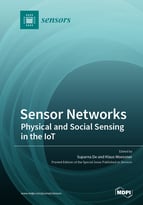Sensor Networks: Physical and Social Sensing in the IoT
A special issue of Sensors (ISSN 1424-8220). This special issue belongs to the section "Internet of Things".
Deadline for manuscript submissions: closed (10 December 2022) | Viewed by 62060
Special Issue Editors
Interests: Internet of Things; data analytics; social computing; semantics
Special Issues, Collections and Topics in MDPI journals
Interests: context and Situation awareness; sensor and actuator network; wireless communication systems
Special Issues, Collections and Topics in MDPI journals
Special Issue Information
Dear Colleagues,
Advances made in the Internet of Things and other disruptive technological trends such as Big Data analytics and edge computing are contributing enabling solutions to the numerous challenges affecting modern communities. With Gartner reporting 14.2 billion devices in 2019 and, according to some reports, a projected 75 billion IoT devices that will be deployed by 2025 in areas like environment monitoring, smart agriculture, smart healthcare or smart cites, one could think that most issues are already resolved. However, there remain practical challenges in large-scale and rapid deployment of sensors for diverse applications, such as siting optimization methods and participant recruitment and incentive mechanisms. On a higher level, the deluge of data sources that drive the IoT phenomenon grows every day with the rise of smartphone-enabled citizen sensing data on social networks and personal health devices, as well as with increasing connectedness, be it in the transport, logistics, utilities, or manufacturing domains, this range and complexity of the available data calls for even more advanced data processing, mining and fusion methods than those already applied.
Dr. Suparna De
Prof. Dr. Klaus Moessner
Guest Editors
Manuscript Submission Information
Manuscripts should be submitted online at www.mdpi.com by registering and logging in to this website. Once you are registered, click here to go to the submission form. Manuscripts can be submitted until the deadline. All submissions that pass pre-check are peer-reviewed. Accepted papers will be published continuously in the journal (as soon as accepted) and will be listed together on the special issue website. Research articles, review articles as well as short communications are invited. For planned papers, a title and short abstract (about 100 words) can be sent to the Editorial Office for announcement on this website.
Submitted manuscripts should not have been published previously, nor be under consideration for publication elsewhere (except conference proceedings papers). All manuscripts are thoroughly refereed through a single-blind peer-review process. A guide for authors and other relevant information for submission of manuscripts is available on the Instructions for Authors page. Sensors is an international peer-reviewed open access semimonthly journal published by MDPI.
Please visit the Instructions for Authors page before submitting a manuscript. The Article Processing Charge (APC) for publication in this open access journal is 2600 CHF (Swiss Francs). Submitted papers should be well formatted and use good English. Authors may use MDPI's English editing service prior to publication or during author revisions.
Keywords
- Rapid deployment of sensor networks
- Context-awareness for smart IoT environments
- Cloud virtual sensors in IoT
- Virtual sensors modelling using neural networks and/or deep learning
- Crowd sensing and related issues for IoT applications
- Techniques for spatio-temporal big data analysis of IoT datasets
- Large-scale IoT data fusion techniques with computational intelligence
- Multi-sensor fusion approaches
- Pattern derivation through visualization
- Correlation between physical and social data streams
- Applications of IoT sensor networks, including analytics and visualization
- Applications based on heterogeneous data in IoT networks, such as eHealth, traffic, infrastructures, environment monitoring, etc.








